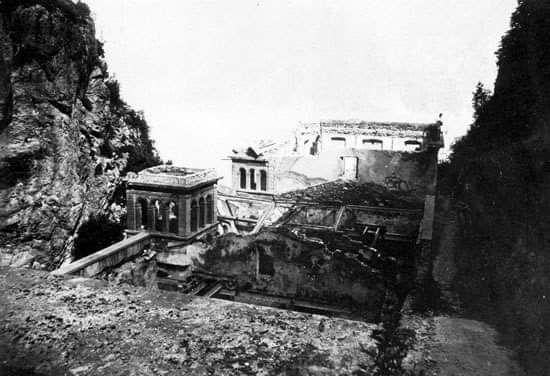
Centrale Idroelettrica "Riva"
Str. del Ponale Riva del Garda TN
IT EN DE
Verso la fine del XIX secolo, il territorio di Riva del Garda si trovò di fronte alle opportunità di sfruttamento idroelettrico offerte dai torrenti Albola, Varone e Ponale, celebre per la sua cascata "Ponalefall" con un salto d'acqua di 60 metri. Dopo uno studio preliminare negli ultimi anni dell'Ottocento, la scelta cadde sul torrente Ponale e nel 1893 iniziarono i lavori, condotti dall'"Atelier de Construction e Oerlikon" della Svizzera. La portata del torrente Ponale, misurata con regolarità dal 1907 esclusi gli anni della Prima Guerra Mondiale, fu valutata intorno a 600 metri cubi al secondo. Tuttavia, a causa della mancanza di un bacino di compensazione a monte, la portata e la produzione della centrale erano soggette a forti variazioni stagionali dovute agli eventi meteorologici. L'officina, posizionata a 30 metri sopra il livello del lago di Garda, venne gradualmente ampliata e nel 1915 raggiunse una potenza installata di 1500 kW.
Durante la Prima Guerra Mondiale, l'officina fu minata e resa inutilizzabile, ma rappresentò comunque un importante esempio di sfruttamento delle risorse idroelettriche nella regione di Riva del Garda.
IT EN DE
Towards the end of the 19th century, the territory of Riva del Garda was faced with the opportunities for hydroelectric exploitation offered by the Albola, Varone, and Ponale streams, famous for its 'Ponalefall' waterfall with a drop of 60 meters. After a preliminary study in the last years of the 19th century, the choice fell on the Ponale stream and work began in 1893, conducted by the 'Atelier de Construction e Oerlikon' of Switzerland. The flow rate of the Ponale stream, measured regularly since 1907 excluding the years of the First World War, was estimated to be around 600 cubic meters per second. However, due to the lack of an upstream compensation basin, the flow rate and production of the power station were subject to strong seasonal variations due to weather events. The plant, located 30 meters above the level of Lake Garda, was gradually expanded and in 1915 reached an installed capacity of 1500 kW.
During the First World War, the workshop was mined and rendered unusable, but still represented an important example of the exploitation of hydroelectric resources in the region of Riva del Garda.
IT EN DE
Gegen Ende des 19. Jahrhunderts wurde das Gebiet von Riva del Garda mit den Möglichkeiten der Wasserkraftnutzung konfrontiert, die sich an den Bächen Albola, Varone und Ponale boten, die für ihren Ponalefall mit einer Fallhöhe von 60 Metern bekannt sind. Nach einer Vorstudie in den letzten Jahren des 19. Jahrhunderts fiel die Wahl auf den Ponale-Bach, und 1893 begannen die Arbeiten, die vom "Atelier de Construction e Oerlikon" aus der Schweiz durchgeführt wurden. Die Durchflussmenge des Ponale-Bachs, die seit 1907 regelmäßig gemessen wurde (mit Ausnahme der Jahre des Ersten Weltkriegs), wurde auf etwa 600 Kubikmeter pro Sekunde geschätzt. Da es jedoch kein flussaufwärts gelegenes Ausgleichsbecken gab, unterlagen die Durchflussmenge und die Produktion des Kraftwerks starken jahreszeitlichen Schwankungen aufgrund von Wetterereignissen. Das 30 Meter über dem Gardasee gelegene Werk wurde nach und nach ausgebaut und erreichte 1915 eine installierte Leistung von 1500 kW.
Während des Ersten Weltkriegs wurde das Werk abgebaut und unbrauchbar gemacht, stellte aber dennoch ein wichtiges Beispiel für die Nutzung der Wasserkraft in der Region von Riva del Garda dar.

